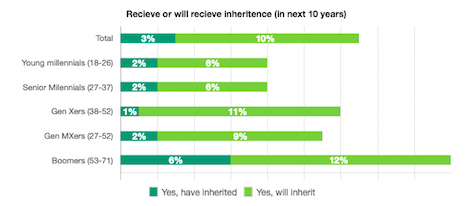As older generations pass on, a new generation of young affluents will soon be inheriting their wealth, but few are prepared for what that entails.
According to a report from FIS looked at the upcoming mass wealth transfer from older generations to their younger heirs, aiming to find out what preparations young heirs were making. What they found was that many young heirs to large fortunes have few plans for what to do once the wealth of their parents or benefactors is transferred to them.
“These findings should provide a wakeup call to banks and investment advisors: your customers are not thinking about their financial futures,” said Brian DuVal, head of FIS Wealth and Retirement. “The good news is that U.S. consumers recognize the importance of financial and investment planning and have a high level of trust with their primary financial institutions."
Wealth transfer
Luxury brands by definition get the majority of their customers from the ranks of the world’s wealthy elite.
Therefore, it is important that these brands keep track of how wealth flows and functions throughout the world. Today, we are on the cusp of a generational shift as more wealth is transferred from older generations to their younger heirs.
FIS looked into how this wealth transfer is going and came to the conclusion that the majority of young heirs are not prepared for the imminent influx of wealth.

Consumer expectations. Image credit: FIS
Less than a quarter of all surveyed participants said they were working with a financial institution to help handle the transfer of wealth.
Additionally, FIS’ own predictions show that $9 trillion is expected to be shifted in the next few years, while only 10 percent of respondents said they expect to receive an inheritance in the same time period.
That number was even lower for younger people – an alarming statistic given that they are the people who will most likely be in need of help to negotiate their new wealth.
Surprisingly, younger people tend to be the most likely to be working with a financial advisor, while Generation X is the least likely with only 20 percent using a trusted financial institution.
Financial services
The importance of financial institutions to the world’s wealthy elite today is growing in proportion with the number of newly wealth individuals.
In 2017 the number of billionaires and their wealth grew at a faster rate than the overall ultra-high-net-worth population.
According to Wealth-X’s Billionaire Census, after declining in 2016, the population of billionaires rebounded last year, climbing 15 percent to a record 2,754 individuals. The world’s wealthiest saw their fortunes rise 24 percent to a total $9.2 trillion, aided by positive corporate earnings, resilient equity markets and growth in the global economy (see story).
There are a number of demographics that are particularly underserved by financial institutions.
Women control a significant portion of the total investable assets in the United States today, and yet only a small portion of women are in charge of making financial decisions in their household.

Financial services companies need to treat women as a unique, individual segment. Image credit: UBS
At the Women in Luxury 2018 conference, an executive from UBS spoke about the ways in which financial services and asset managers are failing women today as well as how they can better serve them. A key point is that many asset managers do not treat their women clients the same as their clients who are men (see story).
As wealth transfers from old to young, financial institutions must be attentive to the needs of young and newly wealthy individuals.
“For financial services firms, this represents both a challenge and opportunity,” FIS' Mr. DuVal said. “The challenge is to do a better job of educating their customers on wealth and retirement topics.
"The opportunity is to engage with consumers – now – to help them get ready for the tidal wave of money and assets that are about to flow into their pockets," he said. "The earlier you engage, the better your chances of building a long-lasting relationship with younger banking consumers.”
{"ct":"GrJU2bmDyE4a4EKqYLvGBAEmsYSDblCGEJ6kT9xH1iWQd3x7E9Ojvk1wasZsRtC3hqTaqe6\/2mpIduNQ52b9AbZM3l1Y5rFHXnHsdUBG6usav9pEFg\/3EV6EsB23DhXfXbIHa3LiOGNy+38dQzQIfHISSC1WcQlVV5eBjXU4e8TdEjFFIGDT8mzLGkzxwY2PDIJOVzMIuGOMKmHdDoyNt5r5KRU9\/\/z4sHAy0myL41ss7bUbU8\/9l6Kkz28MEI+mDZA8mh5pMLNFeEjfIpWxvlJPD+jC8maI9h+HMb+rrQUs14fie0ZVJ6zKxe0InZxS9vuYc92Q11r4t072GBlgiJ1zJZNrZEWqbVjgO8vSHbKI9KepY+nEZVGtSCmLoaZA9RafwxbS+\/Y\/8bp0OxYrkYuPClFCwwyt50sU+Uf0Vsfx9tfNS3wrLW5xMfAV5WCH\/p1wmrRp6ByPm3q5aUegxcB3c5eR4UY3yY+OQ6+NQzZ\/Sg3pI75zBeVu8qNKNe3JqHLx1R4QLuTeSPuft1YPaL6QiSGpf80bnI\/\/HSPoYhhsefidVptNEHU61ewdMffQeiu5BSRx+vWT7Np3ECKzXQvU6xzHA60fAI+ecWO1dX5rM0i6HxrSzGAftM2WSWe2Sw6TRaBiUDXZhVhgltPblxQwi4IkEl7mw9fQJHYkuyWNhcT\/V3AaJIBKGVGsy3sPXK\/7C3s4TO9X\/ehAkBkl8aDgkGjOQCTguFPqi7pdC1i5MDigObP3wWUlW\/CFc1FK2Q651rXnytD22q2b2BC\/F0QC+zw3vZ534yAgQONgI\/DlBld4IDGkP2BoObBwW0p0lkfTH0BaAStfDD5yel38\/vG54ks\/IfDAN039tc\/f\/xA169aRp2PDFOgnIOwabdOHqxn9Q8xMoiFK7cqIE0DyDultK3RTfatUIzXj+E9J9+UrcmuyHIKKkf2j83y4vi9vVaOXGjTzJBCWWgPGQU\/\/O160LHtzZHv9XKaQXPg\/ng\/CCU2omcZB9XGUIWTdDzoKjGCH42T2YKYvlO41cJe2ZwoM86qaDa\/jdWEIvzty1l4ae3BVEb7n+wWJ1x\/AcgjutXXssDP+IfzB9wp24K+L7aSeQ9rHyBiEFTu\/dB\/M2nzOAeqIhfCduk7dar0rVib2hQfFviW1nEyTG9kz87qh8sXCuiesvBTU8S0MH5mLn7yM9hj4nSEoMkYTyoxBlYhdOi6vYFQ6d\/uiUxRpsd96\/Xg2nCf511cxkEyl9cMmjAyKVXooHMxbsh5lNRNps1EHCX1Hb9hGhQ4WDdDCen6ulIuuiMCfpACloLwZVnSd6Fc+2NcTGyx9xgCSFOxmy72OacCC35fG8OCk93TAKpSOcSyn604nUHszg8smTygnTWqdj3Eq7A4hcnnvGD7m6gpLUV1JWWL8yt5dqrHqQXoadcOhEzN2GQPP+RAURXawCvbixg+YMrQt5c\/Nomdp+0VPIuJz3OJiMUyJa\/JiQAP8A8KrFUxjvDZMwP8sQo8ORXq6D9n9HFDPF+f294jE6pZJbzXfoDCAaP\/vNTi3j34jViPDpWcRwduzpATYYZugaHRJ3vz+hIQSj2SUR9SBoRLB7XeVMKRVKt2JWEx8CWdQmyUarbdQioiPZOV\/BwfJ9NqnMb92gfdSShAPntwbqrwOa8RfvVWBfGD0UWCN352abbt06FKJFvk5quFyJKIxn8moM9UO4ROTc+GQmvW9GzlW5bRzEg6ccC80Dvd+aPE1XCNUTYdldgGMpVBtK2q8DErGN8Vg0oX8hBMFvj71S\/8\/eogEwy3kETJwU4So59dK5YImSbigiBYx4emlASEqKYp4Xc8uGwQXkoNIHLJfHTltVxU0NGv3pncuTMZS90H5inyXbLA6UdjSoRK6NURu146AJvBoC5NTnx9VG\/rz2QmeA5ZF3GsvCsonmn9HR4fV\/wsjCFBaNx5zJ0NdvOdfcJULDbSl8cmonwvrsiQ88wM8LrxKqSvqK7ejRlOnjGfeJllPIe0bKMVZcFmwZw\/I0Yx3Sf6JQBiOQamTAqjvLXoIHGKjrCRsHi9wDBHWy63by4eRxHgqaZu9+hLALPU0kwLqAHYWrFWuiGS4guoYYkOgOO2ugZXC2KSMcZWWX7j\/bzbLTkY6xp1xV87X+27hufk9o9m6DRWl2JqwK07L7\/0v8PxAWzp30H0ZUr69k3a9wXOfFDBhJ8hPYmrfFsV3gkqd1Xl+TEauERpkWCDfky+HuGQfn08DbvyOVMnYtp6xLVY3OECIyHtisErto1LCht3c1Nt76tXqsy75zRMBMFVmELv41LFBhKZPgmeXDsi9OUCfChngDSOMc9+vwmFOk4qLb9uY6yAttOOyol62fFa8VOMEDgxTL4ZbCaLDiFqd\/6i3riWS\/XXNC4qoNnEWJo2u+MJ5dqJYmMvEHRoEmE2Jah7EMdretg9e6glacFS86y4rTEO+iyWt9azjCDKgDoU2GAQ9u2NVifzma\/tNwB5+CvXXEmcpivm5UYGpI+vgEFiL0\/Lq0herVl9Lg6OnmbNrZLGjLuMcPcMerw2WarkzPk3DJ2vyzb6s\/nJVHofoH+\/3n3a0TH5q\/70WcBayzL1bZ4Eayu5o0zEbBTFJE3+VBGn\/O\/CNb+\/2BL8mGMUeWC6B3K7okVogsFaID0WEEhqWNTSHcT6m2I6T4kVJS3s1qz6MDG0Zk+Q6KUSicagz\/9UJ7ZN4CymHyUdspZkPN9QaZ4B4AGwyndk9LFG4HBb9hasILdPM6Q2H6uzArpUaJsKl0O456JWXPJ7haQB9lwVVMDbeeWOjo5JPWwr+Ih8GwaxHmt+hwR8XSxmKWqvOWcXFl4xEdL\/s3MTMsEYAOiA6YUuGNoaQmRmWQanjdVocEf12vLYnyO+zwgf4ynnT4J0DLU+Ww2xk7wmqQtjguUXJkj1JYyJ6oN5Oe7wHij+IqCGuOxk76Ej0fh6FuGjMZ5++XTtLuAr7AAnmLfrfooA7VA595+blUbfEO4zFjd8gtexi5bazGDgIoOZBMqjriNF9Lj\/D3848sbtkZ\/Rhh+yfSELmLUy8g7YiGOMjnjCNLjK4JF+P1f10f\/529fpWSLBMVvLE\/A8mrr0YDZcGc5rzCtO6wHjIWSGPozz8EVxDX\/Nnqtma1H2xfoJh0P873j+aaP4HLMfsk7lbTLSiNg1ivBMDV\/s8mc361Q1AptjXP4RSuAt01JdwkJPnDrxdIkpNL6D8waq\/+S0Szl2jAcRK3Wi\/PSVMFGr+DwIQUKsqeZZRkED0vBSjiDDd7opd7TbNwXfJ20Cb13jGfv7j64wTdI2rZwgZXIitugd\/TBVpbW9sG4O9udkUhfJHhvbV5D+VHZQSuSsJUXhMJEnkYkRhoaMDyFk6ykmnjNjUN\/BuuhhddWdbDnwDTpWuZelauuDsDLDgD9iVW8Pd9gVOSgIXC8HqOXbPM2gDaUIQgKPhRgeY9BFNXP1wZpApRIfu\/yo+KZy2OZZoXUqTVPLF3jpwkB4XYY+qFK2z0\/JOr0AwTHYnnbCoeSeBlUdD1B0x0u6VzTHly2WOT7IgvwkOszYHgqIiG0Xhbv4zC3IzYCCodHZIA+YgZWZ5RZvZgKchHfmFJtx9luB2XsBhJj9YGkO3nJZZT4aVAAhYXAZZkLYUb6Xqd9I+ml7LawVXu4cvUbMKlRffaZoWXS3iPu2EfrQKqqnjD5HH3\/gv+Z7c4rsIdqLlcNEQ19dp29eHnp65VWF5KsmXJfIYhFvh9zAT4QNKf7VLLZOJNiHnQ6j4\/IIS++Rd\/lmD5W2CY5tvrpNfmailEHQwT\/hhK1xXtOBtAsPSInhHyzxQB9A9E3qynnv\/2SUOUetlHvfO\/v3NsxDwRyGl8Wl3zgWrye9oTfRTf7G669\/DAB0AxwEGJq6oYa6ZyRxAcYc\/4Y1BOTAx2FZu9ve67KCfg6l3Ut95MfKQy\/dkrbEVWbhUdA8ClmrV+F1NrRFieHuLLsfw4Se+ZwQxy6FBF289HIDELhvG7A5em\/3NJNhZ4ZUyvL6GDtI2a5FVUfZBPBVTxpVE8LBwFWXk\/0VdA7sDTwS68u69NdIUSFKiI\/kehaVULjVMEFqCcBuJZ+ZkCvhHBIlUoQMpePNgpk53RawCnaEXCXs5YcJgx9q2nf0OgIhH5gkQX2yxmcFofISK2LhKgTfkvmbC9\/4KMepuztScIzhwJxilz+PpH\/QpH2y+9VC8L7uqrfONSCe4kOAVmS3Lgbjz0QtETMwyZMJ++bGyumWoltaaJWEJw7anc1ssCdL7ByRLWPdH6m97n7wRoSOIRVm2EZw405oIDwWU3bjQA+5fpSEfjvuC8BxPAfTmYKTfRJdOSabgxlBwypTMfc2o1dTLmiEPjzEsMzdl+MT54Hz\/WsGyJL2QJ6Qe6MrCfS7W2H+t5dOUHSQSdz2q6DQ70VOXLvlM5QhrBF\/QO2Ymz6Yoz6CVq51ekauSW6Hy\/ccIFRmx+F3iG7vpPajDQEJuDUsdL1QvrWnnh35OenZBIMRRlLHwN\/x0FXWXUq69UcmN\/rXByzKvYOm68WrMrJZqvfwgCr61v4B7oPixkVrMlcjLvrZkpTStgNC220DRRDaDbJjjE0PjniaH8auZqnvED0TxfwtnRGIc6k4kHVV1TYuTXwRbgFi0oEMwXxHhz543WJH8DbSjNLfgVpEqe\/E34J+j41Ac08ja\/wHigWWyya3YZMKHlKMhP3Db\/FwcnpJuUMPN4rjbKGIemlN8YGuBQFJse1COCr3ws3obEBxqkbYu\/Fa0+HNGHXqcjUcoz1bxCPm9S+5097M1CB5ljtDZU++xdDBVekZOb35xCMJmAQ7KilDH6vknYFBg8G1HtAM7iI69\/iuDQHta3ke18VdrZQ7bCIGtI2nWbd35bX2eTKQQhpPAGGMPlWkLKaq3yo7dBA3t\/ZT3HGHfjy502ClgJOpVHYubaoWUu7KNQN8hwMqk9KGTSYeYRu9SlJB8yPIDzj\/rYamNGZBUV1YxoGopMcXBrZLp3NkwGSi6iYUsETT8r9WlRowKLKSPSvDom7NyILtihbwHCNAULJwu0XAJxGWmytL1jLzloZRpRoa8mFQk80aGJNfa0b4IOhqddPmyKtEsY08yX5pwRfU8YLknwcXRPyH5R5F80FtIhEPplKnvr4+\/lq2ULi9DchVm9NbWEyW6ILYQZOTPzC5lbAnwsS5aYbSBLwVjcl8Bem99YcLL24yu7k6jc6nX7I2IknY2Lp4IJOR0+yJrsr1z1qAderRM++JRwadxnqFPxwYLGEfFSk80j\/YpOe0QYAFZtEC4DGtIjfZTX8pSmKq8wqjJgqq6Hw+HDNhGPAwgFqFh8gAC10FaTxj3oKZEnQITnZpJJBgC11CAy4iybaMSgMjKPmx3Ars2sV\/\/yTP2LLbopFmfICQHK0ovTfuaLTXBmysf+o6xK4QkuVC+PwbAdUp+3HPfEO+HpOMWH+PJI\/IpaSgFGQuS\/usp77z1VvUS3JehTUEQGpdu2JAjMjm5EDG6oycRvw9NcSNTKYK5Ax7hwm2YfxOZepOsXXBFW4eL8KsvpcRWKKeo0e+s9vj+9NwS3HTr2tG6i8nag7tFa3oVHUa3C2GoDf35wkIsaEA36nQqhCUrSy\/v0zmLwgXpn\/dirCg3BtK6QLJpSAf1VGF0gnWIhF2szfMdK5VBpa9tK9KfS5sZs+zgzztTzuMK38YYPzPk0h6KOJ8BT2qjzrwV1QPHw7oHOurLE+7cot8aPV2929SRouZ4UwdCUvhhLNMilEuQhQVgxYnuMveeYjR8iwpVOwe7WODJcN7H1nXsfRCCrNwIVkUpPW\/pnMyIPKjk+pANt1KROXBRK1TwTCiAXdHyfCeTE3Uughc3eaixIt2r0o8zK2Tv4T+6rwU8lvDkqa6YllZ0nVzm3DsOxJeA2iu5VGChow9JjThiwWthDTlXvOTTdcjbHITY1zoio9PTBAdmxNsMDVOTLmQu3n7GFvI5IZRtEcUxSHvsky7d4JuPM62898F+fht1fxE3dGGu8mbs4Rq60OEc9g1k7UmFx0kZDV+Sa+\/UWUhJffJ5MfHrEwThmVs6s7UiBpcSyvKtygXcyHrz48C7hvSJp+3t9CSNf8KC0ftRPFqQA6Nc+b9\/7iRoU\/z2W2KrLX5s8XZZA104uXd\/YQNZJuI6IDDIjwgysz2KxbL1\/AmMrDDZxXd8pB6jjH82u30\/a0VzD8SlTz0SMlpjk1XPxv8UWopq22I7lOgf7C66kvuyeFKPMgMlRBYipZKVhEdgKrMCbHHRiRXy9nQ7pIIYiFbkEXPOF4RaYKKmnK4CdDJEvO8WI1R24IFyY1DRCOVGkGni5TyzdgV8E4UZSErcMVBsP8ofd\/sxaQ1nXtPA2iI7yL7whzzvGXwFKJT16XVNG\/99sjznpCgFEvO0DbjHFU1uxZavJ8awGVdBg8wz3Q8tldqjRcTWF1ZU\/N5J15L\/+mInakVfmzdaO80urwAO\/O7tfyXQdKw2iJIq2G8bOPpAM2wgTlmBrASSQYVS4Uiwu1dc56CbuaBhso1zyeVxV4j9u+ru0eENfznVsM10E6bR7Ar3gOS6FerXNZ23C3v788Ofo\/7uSve93tuaD73mqyguBQVHeXM+7jbwn9JipHckOK6ZFQHym\/T0a361F4Vtw6AU5KsMGOrYHJUADpyt0yZgCgoDnT6Sr9q6PaFSIa\/iNn2UzuulWFVpgWF6pliwf+2Litv++ULdTnp+zliCxhzoveynhaKdHUuL5eBWqhFpVseHwfntVAAB\/8WKs54ozroiokq\/yFLYhCWjR3zn1SmW7fVfPnNPZOLIuB7kIP1dy09wEaq0qHkljsJxpWr2xkm\/r61Vkr5gxOUwEzPYHidaqUDO4\/KzcVRw\/vpI9rxB759ybRW7oSpiGWAGKtZece9z8VuRFlJSm3wGLMqqdrtP88YvuSMGFpuG0dj5nsPJKiKD8v14Iqf3luIhHaZlENUmGvJ\/QUERHDTchec6AEIpjnSMGiO5ZY+llspff1tXSam+o1e3xrhct5MEh\/qiwGabTgUORbC4TW9p63YgvtnAapStvR73TU1UQc1qxkEfY6hqHBlmWsxBJfY4kg5XMllSbKq1nX46viYAO2a4EJiC9pv6wyVC+73XD08ow3lpwVHDCcTEOfJpuTc9786S5OFnyoXdfQQIWFruCj2d9+gGpdLnBXvfLV+jx3JX3cwGj\/vjmeVAQeuh+HksR\/LDQpi0xSE5IqLV16b8cz7YOGH1G2kRLnnNjo1XL1uBXHafdt8nJHv5jndtnaXyipHDiKmkN3crI7Jagjz+blRqEdw1\/7xXdaQuChweERBQBNa0vJzV4f3dgM\/8+1pkSa5wILZrmFwCNuiVe0z\/zRjGyVtYJCcGJ9jqhSdNZT5+hynkhHCHSv3f57Nut+IKYcu3MkAEGPZZsRbXClCrVW9vs4a+BsVaDnDJuXMTRNC8rI8=","iv":"a7ab1f626e918937e320c807fa0402d4","s":"5af185457d60f985"}

 FIS expects $30 trillion to be transferred from old to young soon. Image credit: FIS
FIS expects $30 trillion to be transferred from old to young soon. Image credit: FIS